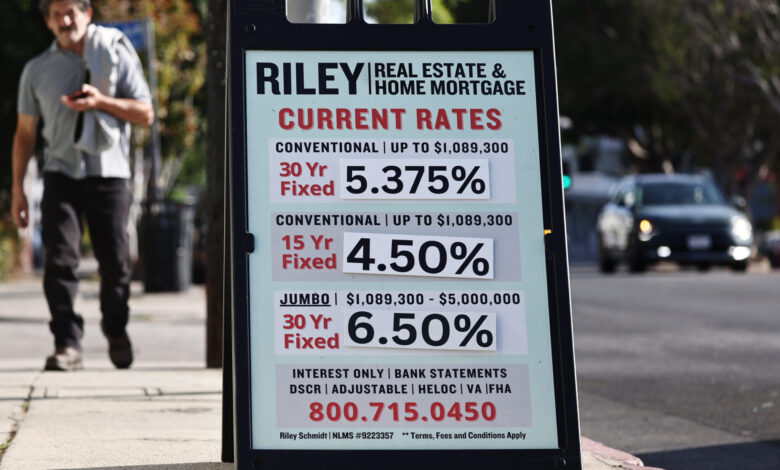Fed says long-awaited rate cut is apolitical, even if

The Federal Reserve’s first major interest rate cut in four years coincides with another major event in four years: the run-up to the presidential election.
Federal Reserve Chairman Jerome Powell on Wednesday announced a half-percentage-point cut in the benchmark interest rate, downplaying the central bank’s role in the race between Vice President Kamala Harris and former President Donald Trump. But that doesn’t stop the candidates’ campaigns from working, and it could be a key factor for voters.
“This is my fourth term as Fed chairman, and it’s the same every election. We always make a point to go to this meeting and ask what is the right thing for the people we serve,” Powell explain. “Nothing else was discussed.”
The decision to cut interest rates for the first time during the Biden administration signals that the Fed’s Board of Governors believes the economy has weathered the wave of inflation caused by the COVID-19 pandemic that has plagued the economy since mid-2021. Between March 2022 and July 2023, the Federal Reserve raised interest rates 11 times.
Inflation peaked at 9.1% in June 2022. The unemployment rate was 4.2% in August, down from 4.3% in July, but still well above the 3.5% level in July 2023 when the Federal Reserve last raised interest rates.
“We now believe the risks to achieving our employment and inflation goals are roughly balanced, and we are focused on risks on both sides of our dual mandate,” Powell said.
Wednesday is the first in a series of key rate cuts expected. Currently, the base interest rate is 4.75% to 5%.
Michelle Bowman, a member of the Federal Reserve Board of Governors, dissented from the other members, the first time a Fed governor has done so since 2005. percentage point).
Time to cut interest rates
Both campaigns reacted quickly to the Fed news.
Speaking at a cryptocurrency-themed bar in New York, Trump said the cuts should be smaller.
“I think if they’re not just playing politics, the big cuts are a sign that the economy is in really bad shape,” the Republican nominee said. “The economy is going to be really bad, or they’re playing politics, one of the two. But it’s a Big cuts.
Harris was forward-looking in a prepared statement.
“While this news is good news for Americans hurt by high prices, my focus is on the future work of continuing to lower prices,” the Democratic candidate said. “I know that for many middle-class and working families, “House prices are still too high.”
Sarah Binder, senior fellow for governance studies at the nonpartisan Brookings Institution and author of “The Myth of Independence: How Congress Governs the Fed,” said presidents have a long history of putting pressure on the Fed, starting with John F. Kennedy The President of the United States has put pressure on the Federal Reserve.
Binder said that in order to effectively play its role in keeping the economy functioning, the Fed needs to be seen as legitimate, and its political support depends on doing a good job.
“The Fed doesn’t have the freedom to sit back or do not do enough, which could also make the Fed a target that politicians really, really don’t want to be,” she said.
Skanda Amarnath, executive director of Employment America, a research group that advocates for full employment, said the Fed should review economic data.
“That’s what they should be focusing on, not where they are in the election season cycle,” she said. “I think that’s generally it. I don’t see any real politicization here.
What the Fed’s interest rate cuts mean for the economy
Many economists and economic advisers advocate that the Fed cut interest rates within months to avoid significant damage to the labor market and, in the worst-case scenario, a recession.
Now, consumers should start to see lower costs for borrowing money to buy homes, cars and other necessities.
Kitty Richards, senior strategic adviser at the Groundwork Collaborative, a progressive think tank based in Washington, D.C., said the Fed should not hesitate to cut interest rates now that inflation is slowing.
“When inflation heats up, the Fed raises interest rates four times in a row by 70 basis points. Now that inflation is under control, they have no reason to let inertia prevent interest rates from normalizing,” she said.
Because housing accounts for a large portion of inflation, Richards expressed concern that if rates are kept at current levels, mortgage rates will be pushed higher, leaving the housing market unaffordable for many Americans. This, in turn, affects inflation, creating a vicious cycle, she said.
Dean Baker, senior economist at the Center for Economic and Policy Research, a progressive economic policy think tank, said the Fed’s decision bodes well for the housing market.
“It’s a good thing that the Fed has now recognized the weakness in the labor market and responded with a sharp cut in interest rates. A bigger boost to the labor market is essentially costless, given that there is little risk of renewed inflation,” ” Baker said in the statement. “In addition, it will help stimulate the housing market, where millions of people have put off selling their homes because of high mortgage rates.”
